Around twenty years ago after my first Cub Scouts meeting I accidently bumped into my lifelong passion in the den leader's den: video games. I sat at his well-aged Atari 2600 for hours playing Boxing, Combat, Night Driver, and a host of others. I was instantly addicted. Later on in the 80s I bought into Nintendo, and then Sega, and even NEC. I was endlessly enthralled with the interactive stories and worlds that unfolded for me every time I jammed in a new cartridge. The challenges were real to me and the passion was heightened when it all went portable for me at the end of 1989 with Nintendo's Game Boy.
The Game Boy was ugly, bulky, and pretty expensive but my god the joy for a 1989 boy. I was speechless as I stared at it in the Toy 'R' Us display. Just the idea that I could take all the goodness of my NES on the road was earth-shattering and the blurry, grayscale, 4-bit, pixel graphics didn't even get a thought. I played Tetris till my thumbs were sore. I played Motocross Maniacs and Batman. I was enthralled. I played and played and played. I had seen the Lynx around but it had no games and I had seen that Bonk kid everywhere but I couldn't afford one of those NEC systems.
About a year and a half later I saw Sega's Game Gear and I said, "wow!". I liked Sega and they'd done all right by me with their Genesis so I figured maybe it was time to try something new. I saved my allowance and earnings from mowing lawns and bought a used one along with Sonic. The batteries died in 2 hours and I sold it within two weeks. I was back to my Game Boy and Final Fantasy asking myself why I ever left.
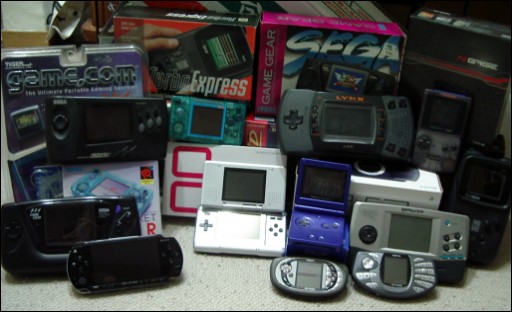
The point? As a gamer in the pre-hype era I lived through the first major portable gaming war without realizing there was one on and for me, like everyone else, it was all about the games and the user experience. Has that changed? No, not much and I expect it never will. Marketing, the internet and the modern super hype machines haven't really changed the basic equation at all despite how loudly everyone now blows their own horns. In fact, all they've really done is accelerated the process of judgment.
So what does all this mean for the current portables war (only really the second ever)? Well, maybe a lot. George Santayana famously said that "those who do not learn from history are doomed to repeat it," and I think comparing past systems to current ones says a lot for what has or hasn't been learned and as well what might occur again. To that end let's look at all the fallen, why they fell, to who they fall, and then see if we can extract some trends.
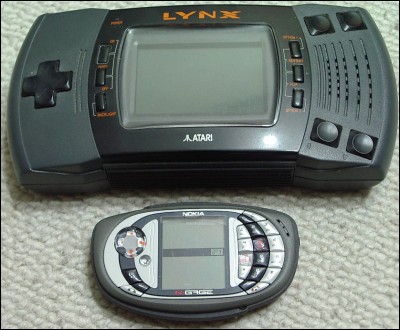 Atari's Lynx
Atari's Lynx
For people who started gaming pre-Nintendo there was no bigger name than Atari. They were the biggest name in the arcades and home systems right through to Nintendo's rise and were even originally approached by Nintendo as the US distributors of the NES (they refused - oops!). Their entry into portable consoles was the often emulated, rarely owned, Lynx.
Pros
- Huge Backlit Color Screen
- Extremely Powerful (More so than the home consoles of it's era)
- Handedness Independent (Left or right handed play at a whim)
- Supreme Multiplayer Experience
Cons
- Too Big
- Poor Battery Life (3-5 hours)
- Weak Name Brand
- No Killer Apps
- Low Game Quality Standards
Atari's Lynx line of handhelds despite being more powerful than Nintendo's home system of the time with a larger screen than the Game Boy, a backlight, color graphics and a multiplayer experience allowing 4 times as many simultaneous players was beaten down by the lowly little 4 bit Game Boy with its ugly screen. Atari was financially too weak in the early 90's to continue pushing their unloved Lynx and the lack of killer apps sealed its fate because all the advertisements and shelf space in the world would not make it fun without them. Atari cancelled the Lynx in favor of trying to regain home console market share with their Jaguar, which itself along with Atari later died.
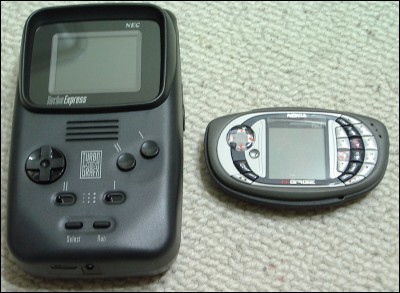 NEC's Turbo Express
NEC's Turbo Express
While NEC wasn't a major player in US gaming circa 1988 they were a strong contender in Asia. Their PC-Engine line was a strong number 2 in the marketplace and with broad developer support and stronger hardware they seemed destined to walk in and own the US market. They launched their PC-Engine, renamed TurboGrafx-16, in the states in 1989 and followed it almost immediately with their stunningly powerful Turbo Express. Unbelievable to the gamers of the era the Turbo Express played the exact same games as the home system, not cut down ports on a different medium, but the exact same games. Awesome!
Pros
- Backlit Color Screen
- Extremely Powerful (Comparable to the home consoles of it's era)
- First Portable Ever To Play Actual Home Console Games
Cons
- Too Expensive (349 USD)
- Too Big
- Bad Battery Life (1.5 - 2.5 hours)
- Weak Brand Name
- Poor Distribution
- No Killer Apps
- Weak Launch
NEC despite their strength in Asia had a really hard time in the states. Developers were content with the NES and later Genesis and NEC couldn't get enough system sales to make them change their tune. In addition NEC's marketing poorly educated the consumer as to their confusing TurboGrafx-16, TurboGrafx CD, and Turbo Express lines and where they all fit together. When 300+ price tags were added into the mix it just kept consumers away. Gamers were happy with their Game Boys and Nintendo Entertainment Systems and at the cost of the NEC offerings really had no incentive to move over. NEC would continue their failures in the US before withdrawing to Asia and later signing off with their swan song, the PC-FX.
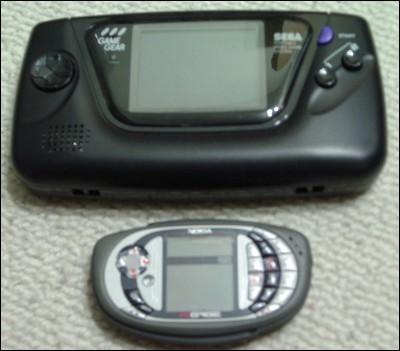 Sega's Game Gear
Sega's Game Gear
By 1991 there were few companies out there who could stand against Nintendo in video gaming. In fact there was really only one, and that was Sega. Despite the pretty broad failure of their Master System, Sega persevered and released the Sega Genesis (Mega Drive if you've got culture). When it surprised many and started to take off Sega decided it was time to parlay their success and follow Nintendo into portables. They recycled the architecture of their Master System, fit it to a decent screen, and the Game Gear was born.
Pros
- Backlit Color Screen (One of the biggest of it's age)
- Powerful
- Killers Apps
- Strong Brand Name
- Recycled an Architecture Developers Were Familiar With
Cons
- Too Big
- Poor Battery Life (2.5-4.5 hours)
Perhaps the most interesting system in this article, the Game Gear was actually a success. While it never managed to dethrone the Game Boy it retailed for several years and managed a following of both users and developers. Ultimately though it fell by the wayside and was forgotten as the interesting apps began to taper off and expectedly consumer interest waned.
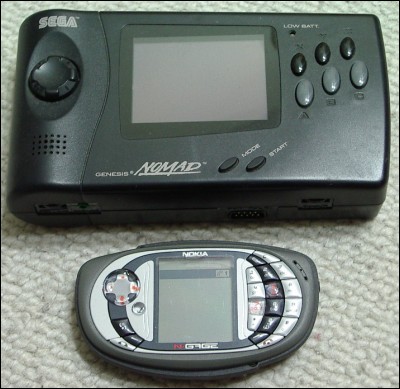 Sega's Nomad
Sega's Nomad
When the Game Gear started to become stale many wondered if it was the end of Sega portables. Sega decided it definitely was not and brought the Nomad to market. This uber powerful portable remained the most powerful portable of all time for years. With the Nomad Sega basically did what they had done years before on the Game Gear and just recycled the architecture of their previous home console, this time the Genesis.
Pros
- Huge Backlit Color Screen
- Extremely Powerful
- Strong Brand Name
- Recycled an Architecture Developers Were Familiar With
- Only The Second Portable To Allow Mobile Play of Actual Home Console Games
Cons
- Too Big
- Bad Battery Life (2-4 hours)
- Ineffective Marketing
If there were lessons to be learned from the Game Gear and it's inability to take the market by storm it seems Sega didn't learn them. The problems of the Game Gear were revisited on the Nomad tenfold. Where the Game Gear was a little too big the Nomad was WAY too big. Where the Game Gear needed too many batteries and they didn't last long enough, the Nomad didn't even have an internal compartment for batteries and could suck them dry like nobody's business. Predictably this confused design combined with ineffective marketing led the Nomad nowhere. It was dead even as it hit the shelves and never amounted to anything in the portable market.
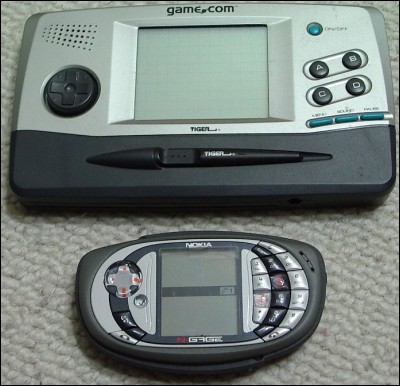 Tiger's Game.com
Tiger's Game.com
Tiger Electronics of 1997 was an aging dinosaur. Their primary claim to fame were a host of pocket LCD games and their line of R-Zone systems neither of which were spectacular money makers especially in the era of the Game Boy when mobile gaming could be so much more. Even Tiger knew it's days were numbered if they didn't make a change. The change they made was their Game.com, a programmable cartridge based gaming system with dual cartridge slots, online capabilities, and portable gaming's first touch screen.
Pros
- Inexpensive
- First Touch Screen In Mobile Gaming (I don't count PDAs)
- First Dual Slot
- First Online Score Compares
- First System To Integrate The Internet
- Integrated PDA Functions
Cons
- Too Big
- Underpowered
- No Killer Apps
- No Clear Market For The Device
- Low Game Quality Standards
- Weak Launch
Affectionately referred to as the Game.bomb online the Game.com was just exactly that, a bomb. Tiger lined up some big name franchises and appeared to have some chance but after two years of retail the Game.com proved it just didn't have enough. To give credit where credit is due Tiger showed dedication to their system revamping it with a follow up, the Game.com Pocket Pro, but by 1999 Tiger was on its last legs and the Game.com line with it. In the end the Pocket Pro versions did no better than the original and Tiger was quietly absorbed by Mattel only to be dismantled and never heard from again.
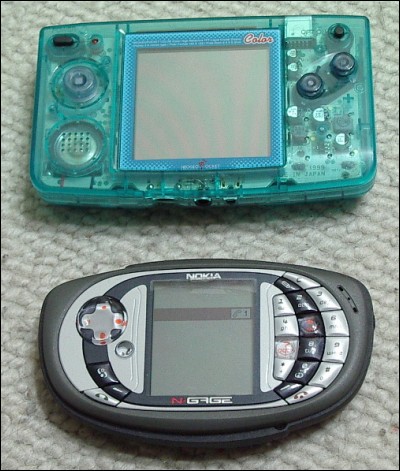 SNK's Neo Geo Pocket Color
SNK's Neo Geo Pocket Color
If you were an arcade gamer in the early 90s, SNK was a name you knew. They had several big franchises and more than a few recognizable characters in their stable. They also made a huge impression on game freaks like myself with the release of the Neo Geo Home System (Yes, I owned and own one) which sported the same hardware as their arcade units and played pixel perfect versions of its games. SNK also turned heads when they marched into portable gaming at the end of the 90s. Despite their strained finances and aging arcade hardware SNK tightened their belts and moved on the portable gaming market in Japan. At the time Game Boy was all but unchallenged and very tech weak. SNK put their thinking caps on and released the Neo Geo Pocket. In very short order it started making decent numbers in Japan. With truly awe-inspiring ambition they set their sights on globalizing the product. They took their award winning design, updated it with color graphics and went global, releasing in Europe, the US, and Japan almost simultaneously. Damn they had a pair!
Pros
- Award Winning Design
- First Internal Battery Backup (For implementing instant on and off auto saves and loads)
- Good Battery Life
- Powerful
- Tons Of Killer Apps
- Good Distribution
- Good Brand Name
Cons
- Poor Third Party Support
- Poor Financial Backing
SNK despite their tremendous brass balls, solid design, and horde of big name titles was just not strong enough for the competition. The Neo Geo Pocket Color did sell well and had a good chance but in the end SNKs finances were not such that they could survive a long war of attrition with Nintendo and with the threat of Nintendo's Game Boy Advance on the horizon decided to bow out gracefully after only a few short months. The Neo Geo Pocket Color was SNKs final contribution to gaming before a long series of mergers and movements that ended them as a series of intellectual properties owned by the Korean firm Playmore.
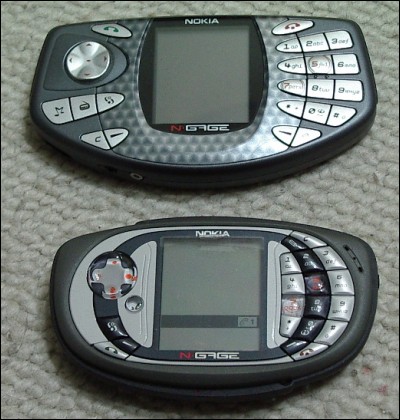 Nokia's N-Gage
Nokia's N-Gage
Cell phones are a growing technology, one that is absorbing other technologies as time goes on and redefining what it is to include them. It is relentless and unstoppable and to quote the Borg of Star Trek fame "resistance is futile". The technologies currently being absorbed: PDAs, digital cameras and MP3 players. Nokia knows this and is pursuing the adaption of their phones, but Nokia is going one step further and attacking the next generation of devices, portable gaming machines. Their first feeler in that direction, The N-Gage.
Pros
- Extremely Versatile Device
- Powerful
- First 3D Capable Portable Gaming Device
- First Wireless Multiplayer Implementation
- First Integration of Cellular Technologies
- Built-In MP3 Player
- Open Development Environment (Want to develop for it, download and get to it)
Cons
- Too Expensive
- Poor Distribution
- Weak Launch
- No Killer Apps
- Weak Design
Nokia were new to gaming and showed it so clearly here. Their design was massively flawed and they seriously overestimated demand with no justification for their stance. While the marketing blitz did get Nokia and the N-Gage talked about the fact that Nokia only gave people bad things to say was detrimental and resulted in lackluster sales generally accepted to be in the neighborhood of 500,000 units worldwide. Not as much a failure as a learning process the N-Gage was replaced as immediately as possible by Nokia's N-Gage QD.
The Unconquered
All of these systems, each and every one fell to an iteration of Nintendo's Game Boy or the overwhelming control it had over market and mind share. The Game Boy was neither more powerful, nor more capable than them in any consistent way. Quite to the contrary each and every one of them (except the Game.com), was significantly more powerful than the Game Boy it was competing against. The Game Boy line's amazing success for the most part seems consistently attributable to the fact that it was more portable than the competition (read that as smaller with better battery life), was widely accepted as the standard by which portable gaming should be measured and always had at least equally compelling content.
Between The Lines Sleeps A Dragon
Now if you're a careful reader and have an analytical mind you already know the conclusions one must draw from this history of the fallen, but I'm going to try and spell them out here so we're all on the same page for next time. Under the assumption that the above statements can all be agreed upon I see portable gaming success and failure as extensions of three basic concepts: portability, believability, and the user experience.
Portability, The Name of the Game
The most obvious, but stunningly the most overlooked factor here is portability. If a "portable" weighs as much as my TV and wouldn't fit in anything short of a backpack is it really portable? If the batteries powering a "portable" last just long enough to get me to the store for another pack of batteries is it really portable? I say no and no along with every other sane gamer out there and might I add Nintendo, but it would seem that time and time again massive gaming companies who should have known better have somehow missed the most basic of concept in PORTABLE gaming: making your system portable.
Believability Isn't Just For Con Men
Equally important but more difficult to quantify, perhaps explain, and certainly to gain is believability. Name brand is part of it, marketing figures in, hitting release dates seems to be a factor, but what exactly is it? To me it's nothing less than faith. People don't have unlimited resources and if companies want gamers to spend their money on a portable entertainment device they need to prove to gamers that that money will not have gone to waste. They need the gamers to believe in them, to trust them, to have faith in their ability to provide what has been promised.
Using Your Users
And finally, if you want to use the users to get rich then you must give the users a user experience that they like and want to continue being a part of. The games must be good, the system must feel right, the process of acquiring the system must be smooth and comfortable. Every stage of involvement should be one where the user is rewarded with feelings of joy and achievement. The purchase of a game should not be a struggle to find a retailer or manage shipping, but should instead by a situation of being overwhelmed by options with only a modest investment of time. Starting a game should not be a long series of frustrating procedures, it should simply be a desire satiated on command.
Now with all this percolating under your hair I would like to humbly request your ear again in Part 2 of our write up where we sit down and talk about everything there is to talk about with respect to Nokia's N-Gage QD, Nintendo's Nintendo DS, Sony's much hyped PlayStation Portable, and portable gaming's second great war. Hope to see you then.
